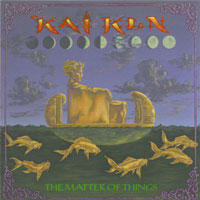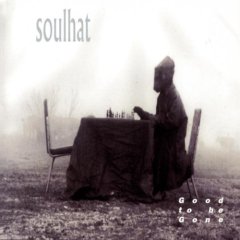KAI KLN & SOULHAT: Extinct Regional Heroes

Kai Kln - Seven - 5/8/93, UC Davis
Kai Kln - For What & What For - 10/30/98, The Boardwalk
Kai Kln - Blur - 10/30/98, The Boardwalk
Soulhat - Bonecrusher - 7/30/94, Floodzone
Soulhat - Wiggin' (with quote to Jeff Beck's "You Know What I Mean") - 7/30/94 Floodzone
My 23-year old brother-in-law told me about archive.org around two weeks ago. "Thousands of free live shows," he said. He's there mostly for the Disco Biscuits and related bands but it definitely sounded intriguing. As expected, 90% had to be jam bands of various sorts, with small allowances for random bands with open recording policies, such as the post-rock Red Sparrowes. I didn't recognize most of the bands, but as I was flying through the index, I was stunned to run into a band name that I had hubristically assumed only I (and the 90s residents of the Sacramento area) was familiar with: Kai Kln.
A record store owner in Brooklyn, who was formerly from Cali, hooked me up after we'd been talking a while and I told him how into progressive hard rock I am. I since found their other two albums in blow-out bins for around $1 each ("Please, take these off
 of my hands. Hell, I'll pay you," the stores seem to say). You got a deal. Especially cause these guy ripped in ways that no one else did. They updated the Zeppelin school by getting a little funky and polishing up the rhythm section a bit while loosening up the songs and guitars to give the impression of a band who was simultanously hard rockin' and laid-back (though this comes through more in their studio material, especially the essential Matter Of Things). The occasional banjo jams did nothing to dispell this impression. This was a band who clearly liked not only the Dead and Zeppelin, but also the mutated guitar mastery of the Meat Puppets and loosely funky post-hard-core of the Minutemen. This was a sound that could have really resonated with the jam band kids who were also into heavier stuff like Zep and Sabbath, as well as with the nascent stoner rock kids who were just starting to get into Kyuss and Monster Magnet. Somehow, despite seeming to have appeal to a wide swathe of people, Kai Kln ended up resonating with pretty much no one outside of the Sacramento area. A friend of mine from Sacramento played on a few of the same gigs as Kai Kln and said they would often draw over a thousand people, unheard of for an unsigned band. If a tree falls in the forest...
of my hands. Hell, I'll pay you," the stores seem to say). You got a deal. Especially cause these guy ripped in ways that no one else did. They updated the Zeppelin school by getting a little funky and polishing up the rhythm section a bit while loosening up the songs and guitars to give the impression of a band who was simultanously hard rockin' and laid-back (though this comes through more in their studio material, especially the essential Matter Of Things). The occasional banjo jams did nothing to dispell this impression. This was a band who clearly liked not only the Dead and Zeppelin, but also the mutated guitar mastery of the Meat Puppets and loosely funky post-hard-core of the Minutemen. This was a sound that could have really resonated with the jam band kids who were also into heavier stuff like Zep and Sabbath, as well as with the nascent stoner rock kids who were just starting to get into Kyuss and Monster Magnet. Somehow, despite seeming to have appeal to a wide swathe of people, Kai Kln ended up resonating with pretty much no one outside of the Sacramento area. A friend of mine from Sacramento played on a few of the same gigs as Kai Kln and said they would often draw over a thousand people, unheard of for an unsigned band. If a tree falls in the forest... Similar story with Soulhat. Super-talented band from Austin that would generate some smoking shows and draw some decent crowds in the early-mid 90s. Their mix was predominantly hard, blues-based Southern rock with a nifty funk cut. Yes, they would get a little folky here, a little country there, a little surreal some place else. But tight, funky, classic, jamming hard rock with some ripping lead guitar was what this band was about. Two problems: first, it wasn't clear where on radio to put them (too off-center, funky, and jamming for post-grunge "rock" formats, too hard and traditionally "rock" for alternative radio). Second, they were really a live band. The studio efforts never did them justice. They still do the occasional gig in Austin.
Similar story with Soulhat. Super-talented band from Austin that would generate some smoking shows and draw some decent crowds in the early-mid 90s. Their mix was predominantly hard, blues-based Southern rock with a nifty funk cut. Yes, they would get a little folky here, a little country there, a little surreal some place else. But tight, funky, classic, jamming hard rock with some ripping lead guitar was what this band was about. Two problems: first, it wasn't clear where on radio to put them (too off-center, funky, and jamming for post-grunge "rock" formats, too hard and traditionally "rock" for alternative radio). Second, they were really a live band. The studio efforts never did them justice. They still do the occasional gig in Austin.Thank heaven for regional vitality. That's what allowed bands like Kai Kln and Soulhat to go for as long as they did, despite being unsigned or ignored by their label. Bands that get get hot in one area tend to have word-of-mouth spread farther and wider these days, often faster than the band's heat warrants. But that's still a generally good thing. Hopefully, current Kai Klns won't fa
 ll through the cracks as easily as they did in the 90s. Then again, as the ability to be heard nationwide, instantly, increases does that demand the increasing formation of a "national" sound? If so, what determines that sound? Could it be the fashions of the biggest media centers, such as New York and San Francisco? To an extent. There will always be fashion, but we've already been seeing dizzying niche-ification, too. Only the niches are not really arranged by geography as they are by interest groups. This might strip some of the unique flavor that can ferment in a certain place at a certain time with the right people and the right fans (early 80s NYC, late 80s Seattle/Minneapolis, etc). This might incent musicians to write for broader, blander audiences. Then again, musicians don't get paid by selling records nationwide; they still gotta play live. And that means playing where their friends and family are. That means home. That means gigs like the gigs on archive.org. That means a great resource for the rest of us.
ll through the cracks as easily as they did in the 90s. Then again, as the ability to be heard nationwide, instantly, increases does that demand the increasing formation of a "national" sound? If so, what determines that sound? Could it be the fashions of the biggest media centers, such as New York and San Francisco? To an extent. There will always be fashion, but we've already been seeing dizzying niche-ification, too. Only the niches are not really arranged by geography as they are by interest groups. This might strip some of the unique flavor that can ferment in a certain place at a certain time with the right people and the right fans (early 80s NYC, late 80s Seattle/Minneapolis, etc). This might incent musicians to write for broader, blander audiences. Then again, musicians don't get paid by selling records nationwide; they still gotta play live. And that means playing where their friends and family are. That means home. That means gigs like the gigs on archive.org. That means a great resource for the rest of us.



